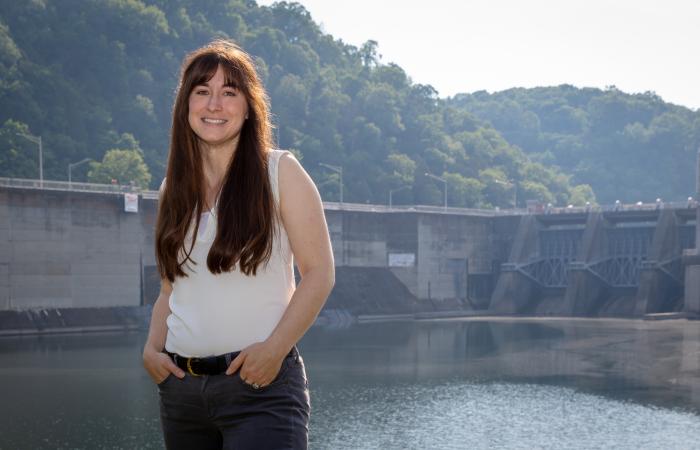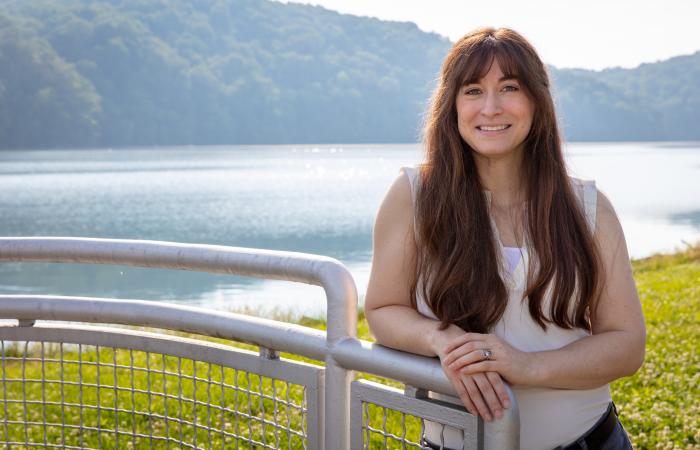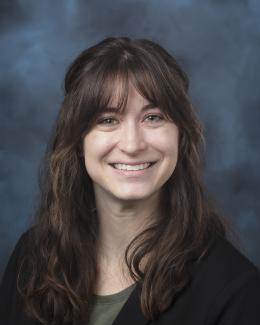Carly Hansen, a water resources engineer at Oak Ridge National Laboratory, is rethinking what’s possible for hydropower in the United States.
Using her skills in engineering, remote sensing and data science, Hansen asks big questions about new hydropower development and what role this unique power source might play in accelerating the country’s transition to clean, flexible and secure energy.
Hydropower is a major source of the nation’s renewable energy, accounting for about 7% of U.S. electricity generation. As a contributor to ORNL’s Standard Modular Hydropower project, or SMH, Hansen is part of a team working to expand small hydropower projects using an approach that emphasizes cost-effectiveness and sustainability.
A key focus of the SMH project is identifying opportunities to add hydropower at the country’s more than 91,000 non-powered dams – those that don’t currently produce energy. Just two years into her time at ORNL, Hansen extends her domestic leadership of non-powered dam opportunity research to international collaboration as the U.S. representative to the International Energy Agency Task Force on Hidden Hydro.
“Non-powered dams are widely recognized as one of the big opportunities to expand hydropower, because we have all this existing infrastructure,” Hansen said. “But it's a really daunting problem for people, because it can be hard to get the information that you need about them.”
In a recent study, Hansen and an ORNL team analyzed what information is needed to better quantify development potential at non-powered dams. The team highlighted the need for more consistency in data and increased use of models to better account for uncertainties related to climate change. They also identified the importance of co-development strategies, such as incorporating hydropower when making repairs to an aging dam.
Hansen authored the paper with a fellow ORNL staff member, a PhD student and a postdoc.
“That was really awesome for all of us, as relatively early career engineers, getting to kind of mark the territory and point to the next steps,” Hansen said.
A love for research
Hansen has enjoyed studying water – and the way people interact with it – ever since her first experience with water quality research as an undergrad.
A math and science-oriented student with a talent for art, Hansen chose to study civil engineering in order to become an architect. But when she took a summer research assistant position with a professor who studied water quality, everything changed.
“At that point I was just supporting other people’s research — but I absolutely loved it,” Hansen said. She switched her emphasis to water resources and pursued a master’s degree with the same professor.
During her master’s, Hansen participated in an exchange program that allowed her to assist with groundwater research at a German national laboratory. The experience improved her coding skills, something she says has been extremely beneficial to her career. It also gave her an early hint that she’d like to work at a national lab.
“It was definitely a different atmosphere than Oak Ridge, but there were still the similar vibes of excitement and enthusiasm for science,” Hansen said.
Hansen shares that enthusiasm for science, which she carried with her through her doctoral work at the University of Utah. There she used remote sensing to model the relationship between water quality and urban areas. She also lent her data management skills to the Western States Water Council, where she learned to appreciate both the scarcity of water and the complexities of water policy.
Although Hansen didn’t focus heavily on hydropower at school, she says the underlying theme of her work was looking at the interplay between human-built and natural water systems.
“That's kind of the umbrella of how I would still describe my research, even in hydropower,” she said.
At ORNL, Hansen is involved in several projects supported by the Department of Energy’s Water Power Technologies Office.
In addition to her work on non-powered dams, she’s contributed to research led by ORNL’s Natalie Griffiths that aims to better quantify greenhouse gas emissions at hydropower reservoirs. Though hydropower is widely considered a source of clean, renewable energy, there are a few pathways by which it can release greenhouse gases. For example, when debris or sediment flows into a reservoir, it can break down and produce gases that bubble up to the surface or get released when water passes through turbines.
The International Hydropower Association created a model to predict these greenhouse gas emissions.
“I'm doing a series of case studies to test some of the limits of the model,” Hansen said. “If we're able to have this representative sample, that will hopefully give us a better idea of what's actually happening in the U.S.”
As part of the WPTO’s HydoWIRES Initiative, Hansen also is developing a data set of U.S. hydropower storage capacity. As more intermittent energy like solar and wind comes online, Hansen said, it’s important to understand how the energy storage provided by conventional hydropower can supplement and add flexibility to the grid.
“On the surface, it seems really straightforward,” Hansen said. “How much water is in the reservoirs and what would happen if you could store or release water when needed?”
But looking at the technical, environmental and legal constraints of the problem makes the challenge much tougher. For Hansen, it’s an exciting opportunity: “It's cool to be tackling this at a time when the need for energy storage is getting more and more attention,” she said.
A steward of the water
Hansen is motivated in her work by a deep respect for water. Growing up in Wisconsin, some of her most formative time was spent at her grandmother’s house on a lake. She recognizes that she’s not alone in having a favorite place tied to water.
“I truly believe that people have a special connection to water,” Hansen said. “I also believe that we have such a responsibility to take care of it and plan for the future.”
Outside of the lab, Hansen makes time for outreach activities. She spoke to students at Roane County’s Midway Middle School for Engineers Week in 2021.
In her free time, she also enjoys exploring East Tennessee’s numerous waterways and hiking trails – and especially introducing her three-year-old to the outdoors.
“I’m definitely trying to raise a water-appreciating child who loves to get out there,” she laughs.
UT-Battelle manages ORNL for the Department of Energy’s Office of Science, the single largest supporter of basic research in the physical sciences in the United States. The Office of Science is working to address some of the most pressing challenges of our time. For more information, please visit energy.gov/science.




